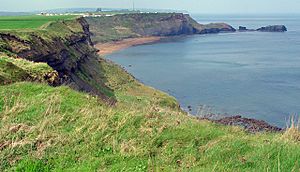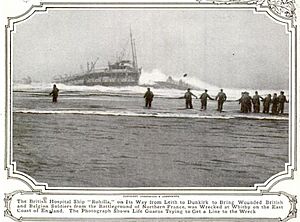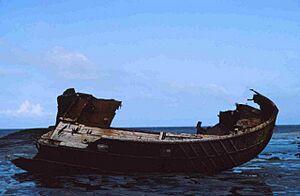Saltwick Bay facts for kids
Quick facts for kids Saltwick Bay |
|
|---|---|
 Saltwick Bay |
|
| Shire county | |
| Region | |
| Country | England |
| Sovereign state | United Kingdom |
| Police | Cleveland |
| Fire | Cleveland |
| Ambulance | North East |
| EU Parliament | North East England |
Saltwick Bay is a beautiful bay that faces north-east, located about 1.6 kilometers (1 mile) east of Whitby in North Yorkshire, England. This bay is home to the Saltwick Nab alum quarries, which are protected as important historical sites. Saltwick Bay is also famous for its amazing collection of fossils.
Sadly, two ships have been wrecked here: the SS Rohilla hospital ship in 1914, and the fishing boat Admiral Van Tromp in 1976. You can reach Saltwick Bay through Whitby Holiday Park.
Contents
A Look Back: Saltwick Bay's History
What is Alum and Why Was it Mined Here?
Alum is a special mineral that was used a lot in the past, especially for making dyes stick to fabrics and for tanning leather. People started digging for alum at Saltwick Bay in the 1600s. Sir Hugh Chomley, who lived at Whitby Abbey, was one of the first people to mine it here.
The alum quarries were built on high points of land and were very large, about 180 meters (590 feet) long and 35 meters (115 feet) deep. The mining stopped in 1791. There are also signs that a medieval (Middle Ages) harbor once existed at Saltwick Bay.
Discovering Ancient Life: Fossils at Saltwick Bay
When miners were digging for alum, they often found fossils! Because of this, Saltwick Bay became known as a great place to find fossils from the Lower Jurassic period, which was millions of years ago.
Some common fossils found here include types of ammonites like Dactylioceras and Hildoceras. You can also find fossilized plant parts. Near a small island in the bay called Black Nab, you might even find Cuspiteuthis tubularis fossils, which are from an ancient squid-like creature.
In 1764, a horse skeleton was found deep inside the alum mines. Later, in 1824, an almost complete skeleton of an extinct crocodile-like reptile called Steneosaurus bollensis was discovered. This amazing skeleton is now on display at the Whitby Museum. Other crocodile fossils, like Steneosaurus brevior, have also been found here. Even bigger ancient sea creatures, like the ichthyosaur (a marine reptile that looked like a dolphin) and the plesiosaur (a long-necked marine reptile), have had their skeletons found at Saltwick Bay.
Shipwrecks and Wartime Use
Saltwick Bay has seen some dramatic events. In 1914, during World War I, the SS Rohilla hospital ship sank near Saltwick Nab. Out of 229 people on board, 146 survived, including all the nurses and Captain Neilson. Mary Kezia Roberts, a survivor of the famous Titanic disaster, was also on board and survived this shipwreck too. Rescuing people was very hard because of the rough conditions, but lifeboats from nearby towns like Whitby and Scarborough bravely tried to help.
In 1917, another ship, the SS Brentwood, was sunk in Saltwick Bay by German mines. During the Second World War, the bay was used as a gun point, meaning there were guns placed there to defend the coast.
More recently, in 1976, the fishing boat Admiral von Tromp was wrecked in the bay. Sadly, two people on board died. You can still see parts of the Admiral von Tromp in the bay today.



